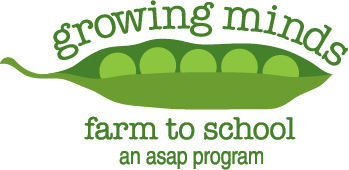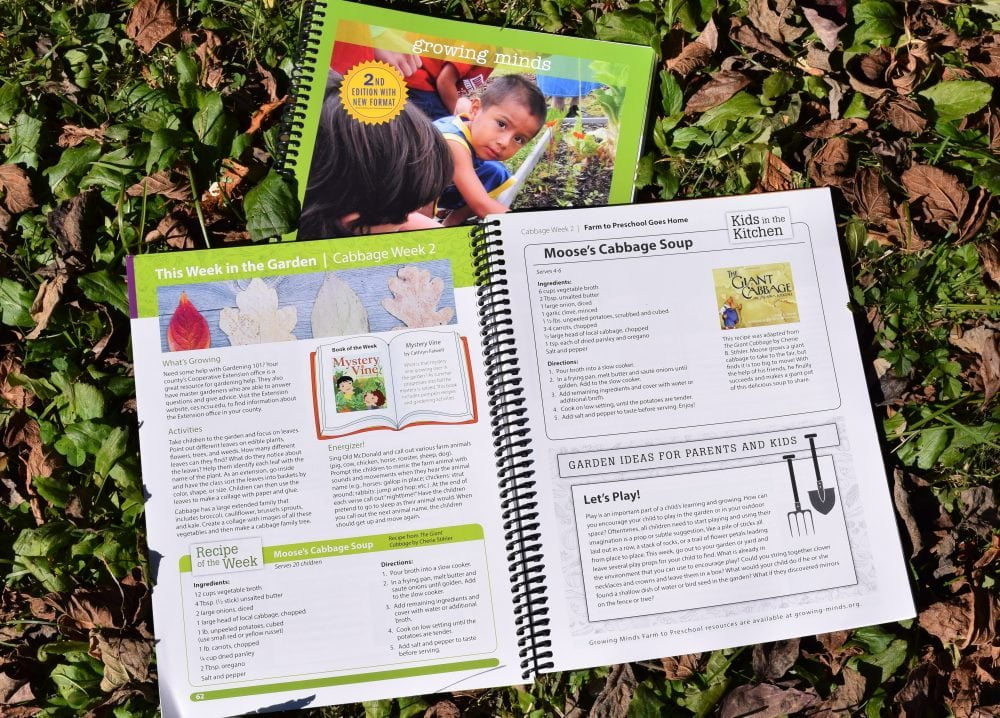The Growing Minds Farm to Preschool Toolkit contains all of our farm to preschool resources, including lesson plans, “This Week in the Garden” activity guides, “Farm to School Goes Home” parent handouts, local food sourcing guidance, and tips for cooking and gardening with young children. It also includes a resource developed by the NC Farm to Preschool Network, “Reach for the Stars with Farm to Preschool“, which aligns the Early Childhood and Infant/Toddler Environment Rating Scales (revised editions) with farm to preschool activities.
This second edition, published in 2020, is updated with a new, easy to use format and streamlined recipes. The Toolkit is available as a free digital download. To download click in the black space to the right of the Toolkit. The download arrow will then drop down. View the Spanish version here.
Webinar: How to Use the Farm to Preschool Toolkit
Early care and education professionals can watch this recorded webinar to get an introduction to the four core components of Farm to Preschool, as well as how to use the Growing Minds Farm to Preschool Toolkit in your preschool, center, or family home.
What’s included in the Farm to Preschool Toolkit?
The core of our Growing Minds Farm to Preschool Toolkit is our year-round farm to preschool curriculum (pages 23-173), which includes 23 lesson plans, weekly seasonal food recipes, This Week in the Garden activity guides for teachers, and Farm to School Goes Home handouts to send home with families.
Additional resources can be found in the toolkit’s introduction (pages 1-20) and appendix (pages 175-196), including information on centering equity and inclusion in early childhood programs, local product sourcing guidance, tips for gardening and cooking with young children, and more.
Finally, the Reach for the Stars resource on page 4 (developed by the North Carolina Farm to Preschool Network) aligns the four core farm to preschool activities (edible gardening, farm field trips/farmer visits, local food classroom cooking/taste tests, and local food served in meals or snacks) with the Early Childhood Environment Rating Scale, Revised Edition (ECERS-R) and with the Infant/Toddler Environment Rating Scale, Revised Edition (ITERS-R).
How is this toolkit organized?
The core curriculum is divided into nine produce-themed units based on the types of local produce that schools and childcare centers can source throughout the year. We chose to structure this curriculum around products that are affordable, readily available, and appealing to young children. Each product unit appears in order of its seasonal availability in our mountain region of Western North Carolina, where tomatoes are widely available at the start of the school year (August and September), locally grown apples can be sourced throughout the fall and winter (November through March), and strawberries come into season in late spring (May and June).
We encourage you to move through the book in the order presented, but if it makes more sense (based on your growing region, your curriculum, or your program structure) for you to skip around or shift your starting point, feel free to do so. During the spring, summer, and fall seasons when the widest range of locally grown produce is available, each product unit lasts for four weeks. The apple and greens units that correspond to our winter growing season (when less local product is available) are 11 weeks and eight weeks long, respectively.
In each product-themed unit you will find:
- Two to four lesson plans aligned with the North Carolina Foundations for Early Learning and Development. Lesson plans that incorporate a CACFP reimbursable snack are tagged as such, with recipe and reimbursement details outlined in the CROSSWALK tool on page 17.
- This Week in the Garden resources for classrooms (left hand page), including seasonal gardening tips, classroom activities and energizers, a recommended farm to school children’s book, and a local food recipe scaled for 20 children.
- Farm to School Goes Home handouts for families, which can be photocopied and sent home with children (right hand page). Each handout includes an at-home recipe that reinforces the local food eaten in the classroom that week, as well as simple, seasonally-appropriate gardening ideas for parents and children.
Each recipe in the toolkit features one local produce item that corresponds to that unit’s produce theme. Other local food items in the ingredient list may also be available in your area, including fruits and vegetables, dairy products, eggs, bread, and honey. If it makes sense for your center to source additional local ingredients for a recipe, we encourage you to do so. View the seasonal produce availability chart on page 20 to find out which seasonal produce is widely available each month in the Southern Appalachian region.

